HSBC Financial Performance and Market Positioning Report
VerifiedAdded on 2020/01/28
|12
|2882
|359
Report
AI Summary
This report provides a comprehensive analysis of HSBC, a British multinational banking and financial holding company. It begins with an introduction to the banking sector and its importance to the UK economy. The main body of the report details HSBC's major competitors, including BNP Paribas, Citigroup, and China Construction Bank Corporation. It then explores HSBC's market positioning, strategic goals, and competitive advantages, such as supply chain management, pricing strategies, brand value, marketing, and human resources. The report utilizes Porter's Five Forces model to assess the competitive environment and concludes with a SWOT analysis, evaluating HSBC's strengths, weaknesses, opportunities, and threats within the UK market. The conclusion summarizes the findings and emphasizes the opportunities for HSBC to enhance its brand position and target customers effectively.
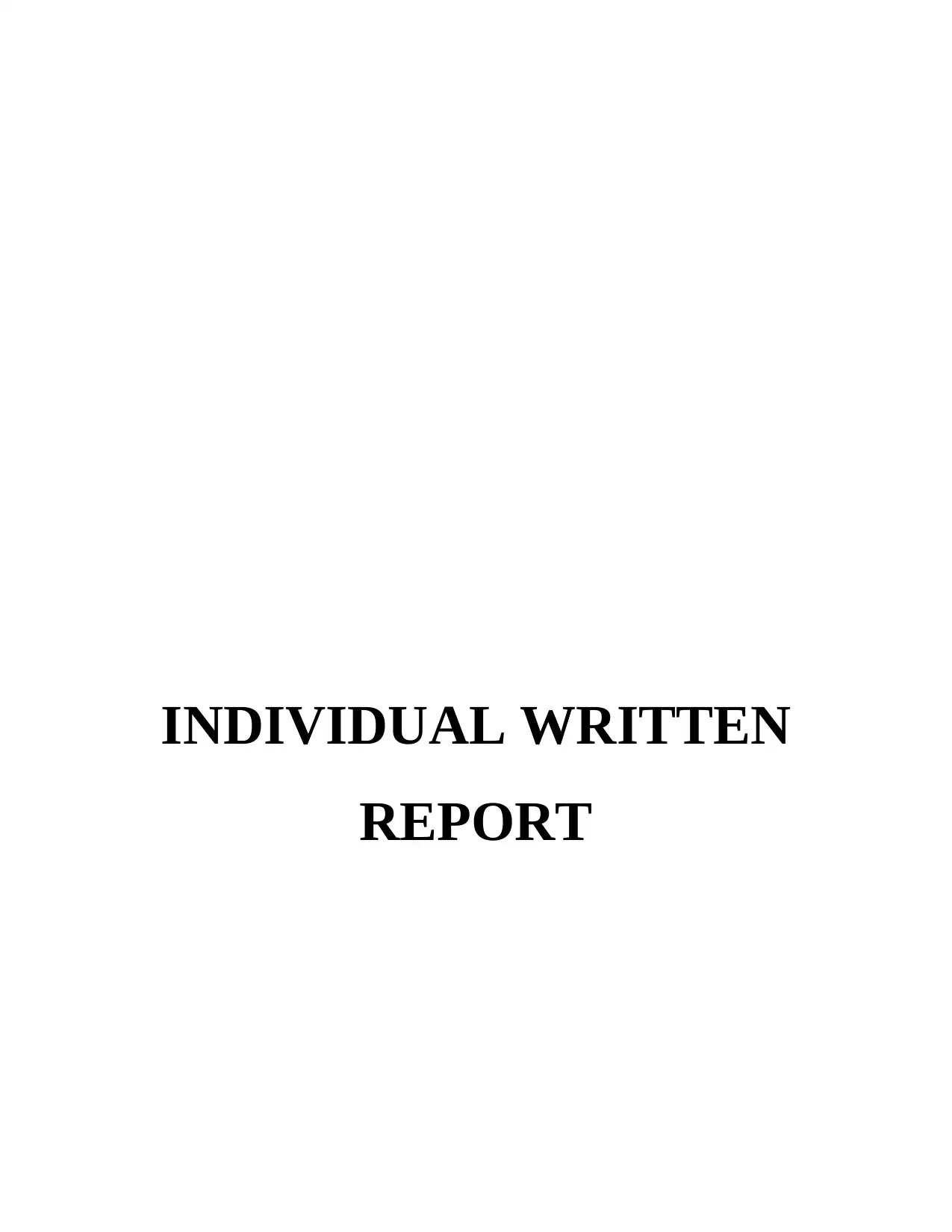
INDIVIDUAL WRITTEN
REPORT
REPORT
Paraphrase This Document
Need a fresh take? Get an instant paraphrase of this document with our AI Paraphraser
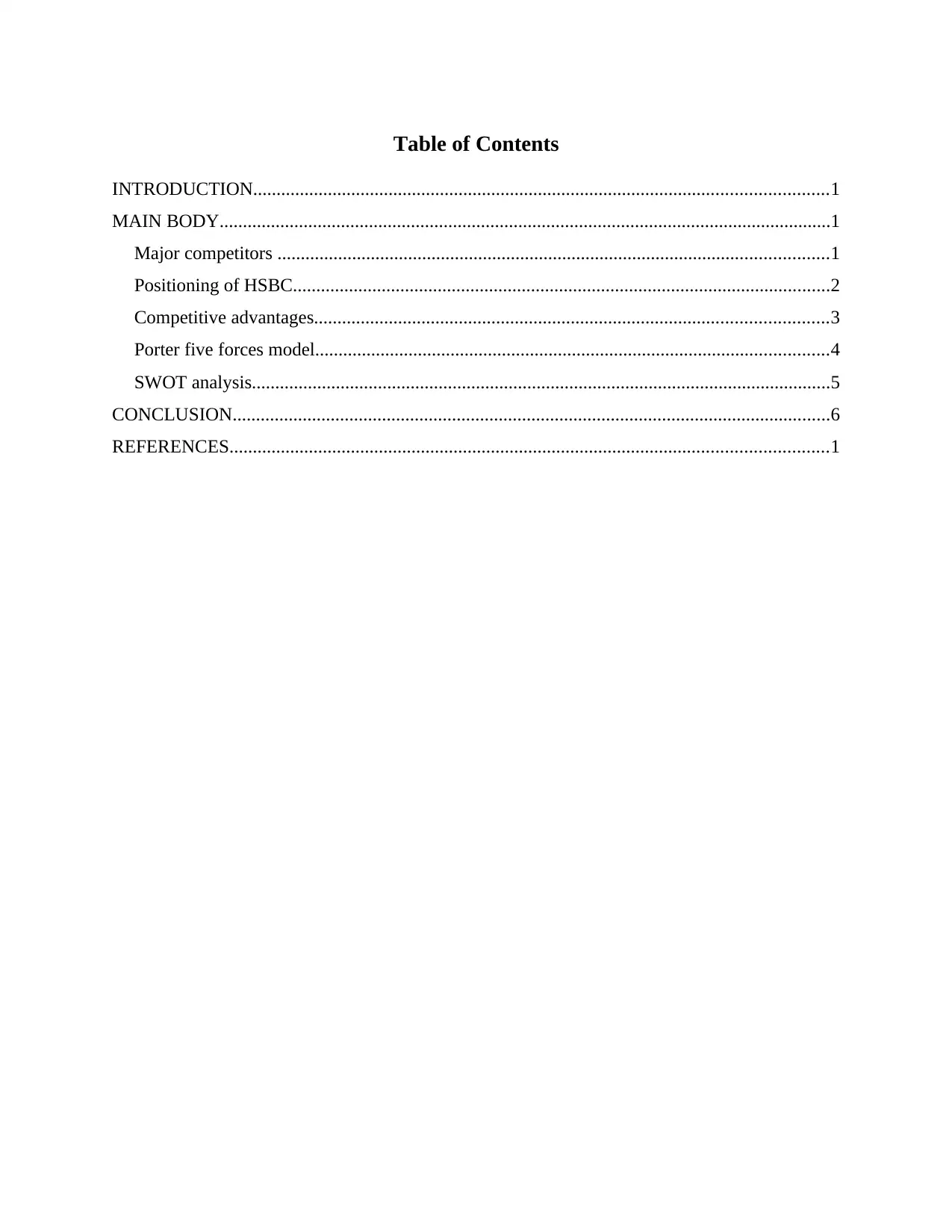
Table of Contents
INTRODUCTION...........................................................................................................................1
MAIN BODY...................................................................................................................................1
Major competitors ......................................................................................................................1
Positioning of HSBC...................................................................................................................2
Competitive advantages..............................................................................................................3
Porter five forces model..............................................................................................................4
SWOT analysis............................................................................................................................5
CONCLUSION................................................................................................................................6
REFERENCES................................................................................................................................1
INTRODUCTION...........................................................................................................................1
MAIN BODY...................................................................................................................................1
Major competitors ......................................................................................................................1
Positioning of HSBC...................................................................................................................2
Competitive advantages..............................................................................................................3
Porter five forces model..............................................................................................................4
SWOT analysis............................................................................................................................5
CONCLUSION................................................................................................................................6
REFERENCES................................................................................................................................1

⊘ This is a preview!⊘
Do you want full access?
Subscribe today to unlock all pages.

Trusted by 1+ million students worldwide

INTRODUCTION
Banking sector demonstrate various types of activities that are related to growth of the
nation. It assists to make smooth functioning in efficient and effective way (Schäfer, Schnabel
and Weder di Mauro, 2016). In UK market there are different types of financial activities runs
which create benefits to different activities and action in market. In this context, present report is
based on HSBC which is British multinational banking and financial holding company. For
focusing on the enterprise, report covers major competitors in this sector. Furthermore, it
includes positioning of the business to attain competitive advantages.
MAIN BODY
Major competitors
In order to make effective results, HSBC is well working in banking and finance sector.
Within the market, there are several competitors take place in market who provides same
services as the chosen firm:
BNP Parlbas: BNP Parlbas is an international banking group which exist in various area of
more than 75 nations. They are providing different types of financial services in these nations. It
is the one of the largest bank in the whole world who serves more than 30 million customers
within retail banking networks (Akbar, ur Rehman and Ormrod, 2013).
Citigroup: Citigroup is an American company which is provides multinational investment and
financial services. It is the public company that owns Citicorp and also holding for several
international subsidiaries. It is ranked at 3rd largest bank in United States. They are providing
services more than 200 million customers over 160 nations (Pessoa and Van Reenen, 2014).
China Construction Bank Corporation: This is the another biggest competitor of HSBC in
international market which exist in China. They are providing products such as finance and
insurance, consumer banking, corporate banking, investment banking, global wealth
management and private equity mortgages credit cards, etc. In addition to this, they are also
maintains overseas branches in different places such as Frankfurt, Luxembourg, Hong Kong,
New York City and Tokyo, etc. (Beck, Degryse and Kneer, 2014).
Deutsche Bank: It is German bank that provides global and financial services in Frankfurt. They
have more than 100,000 employees in various areas of 70 nations. They have large presence in
1
Banking sector demonstrate various types of activities that are related to growth of the
nation. It assists to make smooth functioning in efficient and effective way (Schäfer, Schnabel
and Weder di Mauro, 2016). In UK market there are different types of financial activities runs
which create benefits to different activities and action in market. In this context, present report is
based on HSBC which is British multinational banking and financial holding company. For
focusing on the enterprise, report covers major competitors in this sector. Furthermore, it
includes positioning of the business to attain competitive advantages.
MAIN BODY
Major competitors
In order to make effective results, HSBC is well working in banking and finance sector.
Within the market, there are several competitors take place in market who provides same
services as the chosen firm:
BNP Parlbas: BNP Parlbas is an international banking group which exist in various area of
more than 75 nations. They are providing different types of financial services in these nations. It
is the one of the largest bank in the whole world who serves more than 30 million customers
within retail banking networks (Akbar, ur Rehman and Ormrod, 2013).
Citigroup: Citigroup is an American company which is provides multinational investment and
financial services. It is the public company that owns Citicorp and also holding for several
international subsidiaries. It is ranked at 3rd largest bank in United States. They are providing
services more than 200 million customers over 160 nations (Pessoa and Van Reenen, 2014).
China Construction Bank Corporation: This is the another biggest competitor of HSBC in
international market which exist in China. They are providing products such as finance and
insurance, consumer banking, corporate banking, investment banking, global wealth
management and private equity mortgages credit cards, etc. In addition to this, they are also
maintains overseas branches in different places such as Frankfurt, Luxembourg, Hong Kong,
New York City and Tokyo, etc. (Beck, Degryse and Kneer, 2014).
Deutsche Bank: It is German bank that provides global and financial services in Frankfurt. They
have more than 100,000 employees in various areas of 70 nations. They have large presence in
1
Paraphrase This Document
Need a fresh take? Get an instant paraphrase of this document with our AI Paraphraser

Europe, America and Asia pacific. In 2009, Deutsche was the largest foreign exchange dealer in
world that is 21% of total market share.
Bank of America: Bank of America is multinational company that provides multinational and
financial services. In United state it has 2nd largest rank by assets. In 2016, Bank of America has
the highest revenue (Langfield, Liu and Ota, 2014).
National Australia Bank: It is one of the largest financial institution in Australia market in term
of capitalization and customer base. NAB is ranked 21st largest in term of measuring
capitalization.
Positioning of HSBC
HSBC has purpose to make growth that assist to enable thrive and economies to prosper.
Thus, they can ultimate helps to people to fulfil their needs and hopes through realizing
ambitions. To make long term positioning, they have determines two strategy that are as follows: Develop international network: In order to make international trade, HSBC flows their
capital to serve clients. In this aspect, they can help to small businesses in large
multinational groups (Pessoa and Van Reenen, 2014).
Invest wealth and retail enterprise with local scale: In respect to make global mobility
and creation of wealth, they are determines long term demographic changes.
With the help of investment and value creation, the company can easily enhance
connectivity and GDP growth which flows trade. Now they want to achieve return on equity of
more than 10%. In this way, they can grow their revenue very faster through operating expenses
with adjustment basis (Schäfer, Schnabel and Weder di Mauro, 2016). In these priorities, the
chosen company can easily create high value for customers and shareholders to contributes for
long term sustainability in HSBC. There are various factors which can be influence to strategic
position of the chosen firm. They are as follows: Market conditions: Changing in market conditions can create effect on strategic
positions. Due to reducing of economic growth, brand is also impacted so that HSBC
need to make their position at high price. High quality leaders also forced with quickly
analysing strategy with consumer (Akbar, ur Rehman and Ormrod, 2013). Competitive shifts: Competition of particular industry is also playing a vital role to
demonstrate effective position. This strategy occupy with strategic position within the
2
world that is 21% of total market share.
Bank of America: Bank of America is multinational company that provides multinational and
financial services. In United state it has 2nd largest rank by assets. In 2016, Bank of America has
the highest revenue (Langfield, Liu and Ota, 2014).
National Australia Bank: It is one of the largest financial institution in Australia market in term
of capitalization and customer base. NAB is ranked 21st largest in term of measuring
capitalization.
Positioning of HSBC
HSBC has purpose to make growth that assist to enable thrive and economies to prosper.
Thus, they can ultimate helps to people to fulfil their needs and hopes through realizing
ambitions. To make long term positioning, they have determines two strategy that are as follows: Develop international network: In order to make international trade, HSBC flows their
capital to serve clients. In this aspect, they can help to small businesses in large
multinational groups (Pessoa and Van Reenen, 2014).
Invest wealth and retail enterprise with local scale: In respect to make global mobility
and creation of wealth, they are determines long term demographic changes.
With the help of investment and value creation, the company can easily enhance
connectivity and GDP growth which flows trade. Now they want to achieve return on equity of
more than 10%. In this way, they can grow their revenue very faster through operating expenses
with adjustment basis (Schäfer, Schnabel and Weder di Mauro, 2016). In these priorities, the
chosen company can easily create high value for customers and shareholders to contributes for
long term sustainability in HSBC. There are various factors which can be influence to strategic
position of the chosen firm. They are as follows: Market conditions: Changing in market conditions can create effect on strategic
positions. Due to reducing of economic growth, brand is also impacted so that HSBC
need to make their position at high price. High quality leaders also forced with quickly
analysing strategy with consumer (Akbar, ur Rehman and Ormrod, 2013). Competitive shifts: Competition of particular industry is also playing a vital role to
demonstrate effective position. This strategy occupy with strategic position within the
2
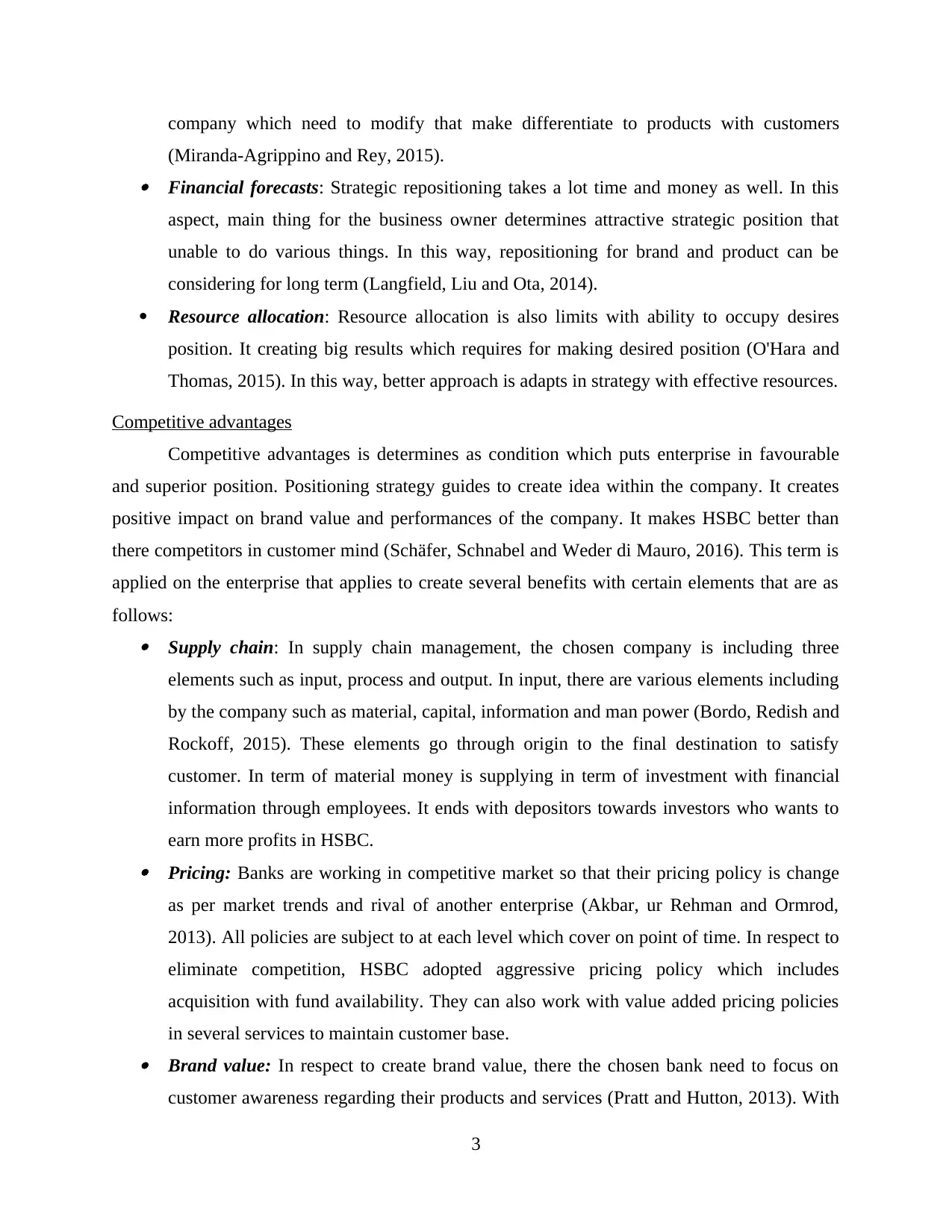
company which need to modify that make differentiate to products with customers
(Miranda-Agrippino and Rey, 2015). Financial forecasts: Strategic repositioning takes a lot time and money as well. In this
aspect, main thing for the business owner determines attractive strategic position that
unable to do various things. In this way, repositioning for brand and product can be
considering for long term (Langfield, Liu and Ota, 2014).
Resource allocation: Resource allocation is also limits with ability to occupy desires
position. It creating big results which requires for making desired position (O'Hara and
Thomas, 2015). In this way, better approach is adapts in strategy with effective resources.
Competitive advantages
Competitive advantages is determines as condition which puts enterprise in favourable
and superior position. Positioning strategy guides to create idea within the company. It creates
positive impact on brand value and performances of the company. It makes HSBC better than
there competitors in customer mind (Schäfer, Schnabel and Weder di Mauro, 2016). This term is
applied on the enterprise that applies to create several benefits with certain elements that are as
follows: Supply chain: In supply chain management, the chosen company is including three
elements such as input, process and output. In input, there are various elements including
by the company such as material, capital, information and man power (Bordo, Redish and
Rockoff, 2015). These elements go through origin to the final destination to satisfy
customer. In term of material money is supplying in term of investment with financial
information through employees. It ends with depositors towards investors who wants to
earn more profits in HSBC. Pricing: Banks are working in competitive market so that their pricing policy is change
as per market trends and rival of another enterprise (Akbar, ur Rehman and Ormrod,
2013). All policies are subject to at each level which cover on point of time. In respect to
eliminate competition, HSBC adopted aggressive pricing policy which includes
acquisition with fund availability. They can also work with value added pricing policies
in several services to maintain customer base. Brand value: In respect to create brand value, there the chosen bank need to focus on
customer awareness regarding their products and services (Pratt and Hutton, 2013). With
3
(Miranda-Agrippino and Rey, 2015). Financial forecasts: Strategic repositioning takes a lot time and money as well. In this
aspect, main thing for the business owner determines attractive strategic position that
unable to do various things. In this way, repositioning for brand and product can be
considering for long term (Langfield, Liu and Ota, 2014).
Resource allocation: Resource allocation is also limits with ability to occupy desires
position. It creating big results which requires for making desired position (O'Hara and
Thomas, 2015). In this way, better approach is adapts in strategy with effective resources.
Competitive advantages
Competitive advantages is determines as condition which puts enterprise in favourable
and superior position. Positioning strategy guides to create idea within the company. It creates
positive impact on brand value and performances of the company. It makes HSBC better than
there competitors in customer mind (Schäfer, Schnabel and Weder di Mauro, 2016). This term is
applied on the enterprise that applies to create several benefits with certain elements that are as
follows: Supply chain: In supply chain management, the chosen company is including three
elements such as input, process and output. In input, there are various elements including
by the company such as material, capital, information and man power (Bordo, Redish and
Rockoff, 2015). These elements go through origin to the final destination to satisfy
customer. In term of material money is supplying in term of investment with financial
information through employees. It ends with depositors towards investors who wants to
earn more profits in HSBC. Pricing: Banks are working in competitive market so that their pricing policy is change
as per market trends and rival of another enterprise (Akbar, ur Rehman and Ormrod,
2013). All policies are subject to at each level which cover on point of time. In respect to
eliminate competition, HSBC adopted aggressive pricing policy which includes
acquisition with fund availability. They can also work with value added pricing policies
in several services to maintain customer base. Brand value: In respect to create brand value, there the chosen bank need to focus on
customer awareness regarding their products and services (Pratt and Hutton, 2013). With
3
⊘ This is a preview!⊘
Do you want full access?
Subscribe today to unlock all pages.

Trusted by 1+ million students worldwide
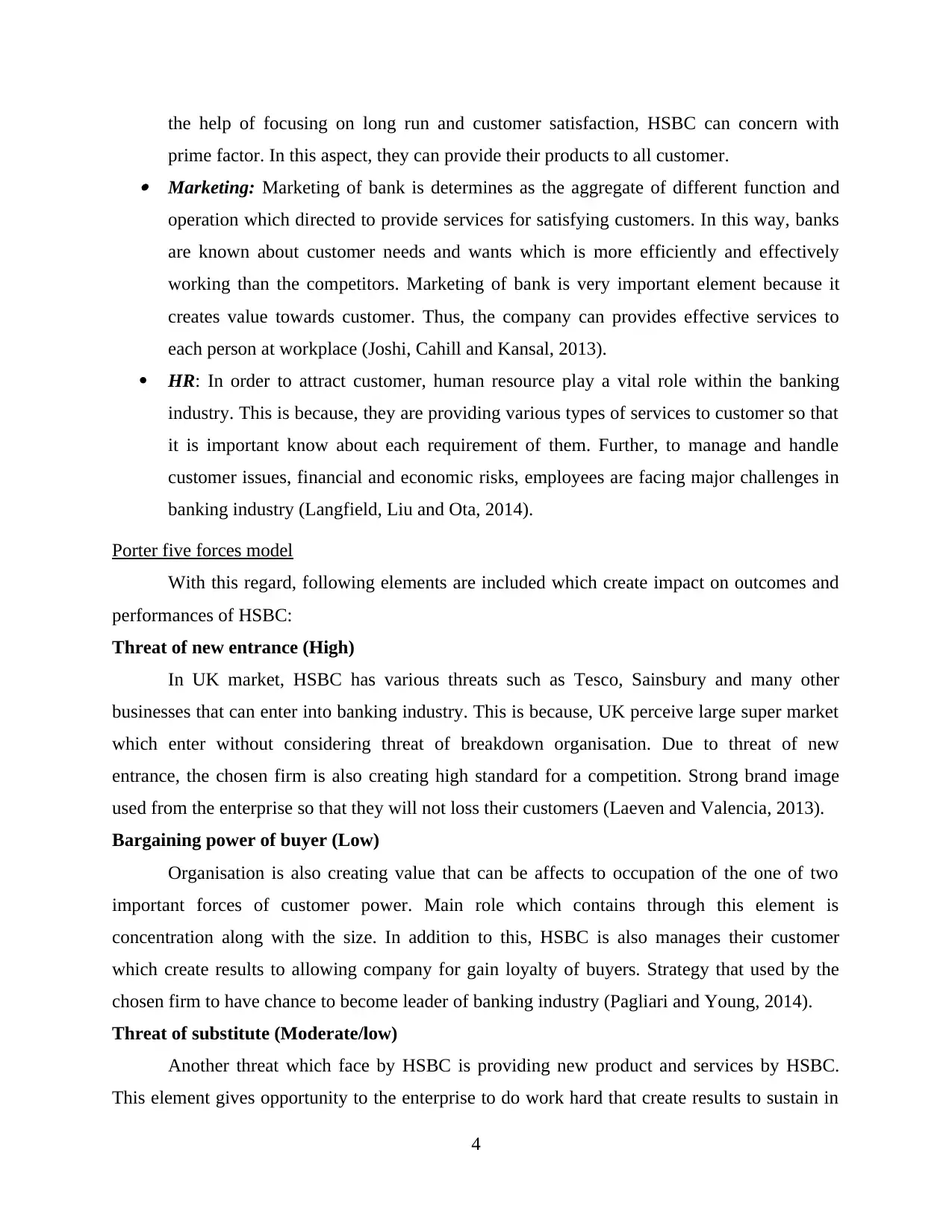
the help of focusing on long run and customer satisfaction, HSBC can concern with
prime factor. In this aspect, they can provide their products to all customer. Marketing: Marketing of bank is determines as the aggregate of different function and
operation which directed to provide services for satisfying customers. In this way, banks
are known about customer needs and wants which is more efficiently and effectively
working than the competitors. Marketing of bank is very important element because it
creates value towards customer. Thus, the company can provides effective services to
each person at workplace (Joshi, Cahill and Kansal, 2013).
HR: In order to attract customer, human resource play a vital role within the banking
industry. This is because, they are providing various types of services to customer so that
it is important know about each requirement of them. Further, to manage and handle
customer issues, financial and economic risks, employees are facing major challenges in
banking industry (Langfield, Liu and Ota, 2014).
Porter five forces model
With this regard, following elements are included which create impact on outcomes and
performances of HSBC:
Threat of new entrance (High)
In UK market, HSBC has various threats such as Tesco, Sainsbury and many other
businesses that can enter into banking industry. This is because, UK perceive large super market
which enter without considering threat of breakdown organisation. Due to threat of new
entrance, the chosen firm is also creating high standard for a competition. Strong brand image
used from the enterprise so that they will not loss their customers (Laeven and Valencia, 2013).
Bargaining power of buyer (Low)
Organisation is also creating value that can be affects to occupation of the one of two
important forces of customer power. Main role which contains through this element is
concentration along with the size. In addition to this, HSBC is also manages their customer
which create results to allowing company for gain loyalty of buyers. Strategy that used by the
chosen firm to have chance to become leader of banking industry (Pagliari and Young, 2014).
Threat of substitute (Moderate/low)
Another threat which face by HSBC is providing new product and services by HSBC.
This element gives opportunity to the enterprise to do work hard that create results to sustain in
4
prime factor. In this aspect, they can provide their products to all customer. Marketing: Marketing of bank is determines as the aggregate of different function and
operation which directed to provide services for satisfying customers. In this way, banks
are known about customer needs and wants which is more efficiently and effectively
working than the competitors. Marketing of bank is very important element because it
creates value towards customer. Thus, the company can provides effective services to
each person at workplace (Joshi, Cahill and Kansal, 2013).
HR: In order to attract customer, human resource play a vital role within the banking
industry. This is because, they are providing various types of services to customer so that
it is important know about each requirement of them. Further, to manage and handle
customer issues, financial and economic risks, employees are facing major challenges in
banking industry (Langfield, Liu and Ota, 2014).
Porter five forces model
With this regard, following elements are included which create impact on outcomes and
performances of HSBC:
Threat of new entrance (High)
In UK market, HSBC has various threats such as Tesco, Sainsbury and many other
businesses that can enter into banking industry. This is because, UK perceive large super market
which enter without considering threat of breakdown organisation. Due to threat of new
entrance, the chosen firm is also creating high standard for a competition. Strong brand image
used from the enterprise so that they will not loss their customers (Laeven and Valencia, 2013).
Bargaining power of buyer (Low)
Organisation is also creating value that can be affects to occupation of the one of two
important forces of customer power. Main role which contains through this element is
concentration along with the size. In addition to this, HSBC is also manages their customer
which create results to allowing company for gain loyalty of buyers. Strategy that used by the
chosen firm to have chance to become leader of banking industry (Pagliari and Young, 2014).
Threat of substitute (Moderate/low)
Another threat which face by HSBC is providing new product and services by HSBC.
This element gives opportunity to the enterprise to do work hard that create results to sustain in
4
Paraphrase This Document
Need a fresh take? Get an instant paraphrase of this document with our AI Paraphraser

market. It makes effective position to focus on different customer section in various areas. It
assists to sustain within the market in effective way.
Bargaining power of suppliers (Low)
In this UK market, few depositor are exists in market. Thus, this force is creating
effective results and outcomes to release new system and policy (Pessoa and Van Reenen, 2014).
Hence, HSBC has no choice to changes market with different prices according to differences of
each person.
Competitive rivalry (High)
There are many banks that are providing different types of services with effective
technology. It will assist to improve financial control system to make effective results. In the
nation, there is maturity of financial market so that competitiveness force bank is creating profit
continuously. In addition to this, in financial sector, there is also many rivals take place. Thus, it
is important to use efficient strategies that ensure effective leadership position in market (Adrian
and Ashcraft, 2016). Due to capabilities of other rival companies, HSBC need to develop their
plan that assist to make first choice and preference to customer in banking industry.
SWOT analysis
In order to make effective function and operation, it is important to determines position
of company. In this context, following SWOT analysis has been conducted for HSBC in UK
market. In this way, the company can measure their internal performances in effective way
which assist to grow outcomes and results at workplace.
Strength Weaknesses
HSBC has effective strong brand name
and good financial position.
They are perceives different types of
groups such as commercial banking,
investment banking, financial services
and private banking.
In the chosen company more than
2,75,000 people working in global
market.
Decline market of UK is creating
adverse impact on the business
performances.
Various competitors are take place in
areas (Beck, Degryse and Kneer, 2014).
Poor performances in financial market.
5
assists to sustain within the market in effective way.
Bargaining power of suppliers (Low)
In this UK market, few depositor are exists in market. Thus, this force is creating
effective results and outcomes to release new system and policy (Pessoa and Van Reenen, 2014).
Hence, HSBC has no choice to changes market with different prices according to differences of
each person.
Competitive rivalry (High)
There are many banks that are providing different types of services with effective
technology. It will assist to improve financial control system to make effective results. In the
nation, there is maturity of financial market so that competitiveness force bank is creating profit
continuously. In addition to this, in financial sector, there is also many rivals take place. Thus, it
is important to use efficient strategies that ensure effective leadership position in market (Adrian
and Ashcraft, 2016). Due to capabilities of other rival companies, HSBC need to develop their
plan that assist to make first choice and preference to customer in banking industry.
SWOT analysis
In order to make effective function and operation, it is important to determines position
of company. In this context, following SWOT analysis has been conducted for HSBC in UK
market. In this way, the company can measure their internal performances in effective way
which assist to grow outcomes and results at workplace.
Strength Weaknesses
HSBC has effective strong brand name
and good financial position.
They are perceives different types of
groups such as commercial banking,
investment banking, financial services
and private banking.
In the chosen company more than
2,75,000 people working in global
market.
Decline market of UK is creating
adverse impact on the business
performances.
Various competitors are take place in
areas (Beck, Degryse and Kneer, 2014).
Poor performances in financial market.
5
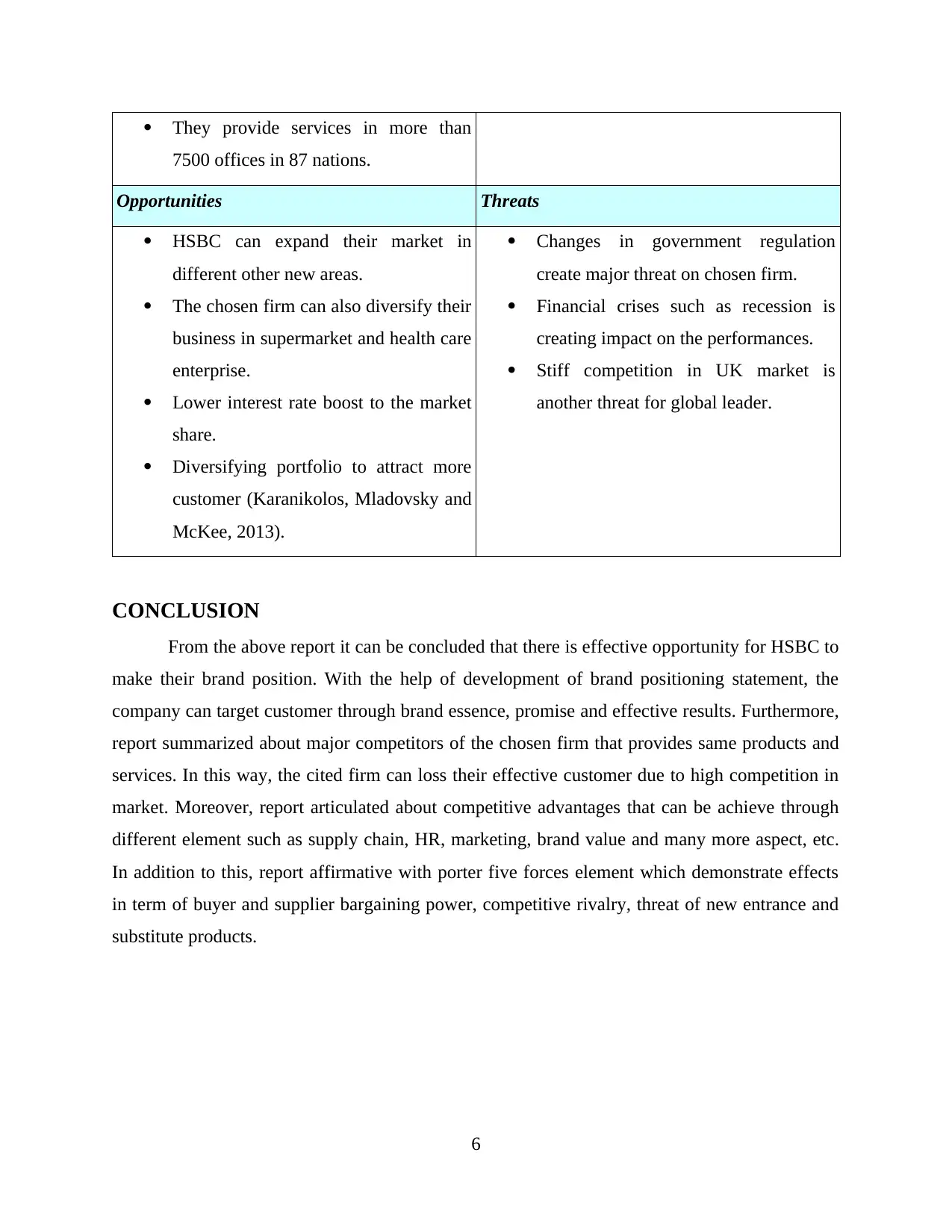
They provide services in more than
7500 offices in 87 nations.
Opportunities Threats
HSBC can expand their market in
different other new areas.
The chosen firm can also diversify their
business in supermarket and health care
enterprise.
Lower interest rate boost to the market
share.
Diversifying portfolio to attract more
customer (Karanikolos, Mladovsky and
McKee, 2013).
Changes in government regulation
create major threat on chosen firm.
Financial crises such as recession is
creating impact on the performances.
Stiff competition in UK market is
another threat for global leader.
CONCLUSION
From the above report it can be concluded that there is effective opportunity for HSBC to
make their brand position. With the help of development of brand positioning statement, the
company can target customer through brand essence, promise and effective results. Furthermore,
report summarized about major competitors of the chosen firm that provides same products and
services. In this way, the cited firm can loss their effective customer due to high competition in
market. Moreover, report articulated about competitive advantages that can be achieve through
different element such as supply chain, HR, marketing, brand value and many more aspect, etc.
In addition to this, report affirmative with porter five forces element which demonstrate effects
in term of buyer and supplier bargaining power, competitive rivalry, threat of new entrance and
substitute products.
6
7500 offices in 87 nations.
Opportunities Threats
HSBC can expand their market in
different other new areas.
The chosen firm can also diversify their
business in supermarket and health care
enterprise.
Lower interest rate boost to the market
share.
Diversifying portfolio to attract more
customer (Karanikolos, Mladovsky and
McKee, 2013).
Changes in government regulation
create major threat on chosen firm.
Financial crises such as recession is
creating impact on the performances.
Stiff competition in UK market is
another threat for global leader.
CONCLUSION
From the above report it can be concluded that there is effective opportunity for HSBC to
make their brand position. With the help of development of brand positioning statement, the
company can target customer through brand essence, promise and effective results. Furthermore,
report summarized about major competitors of the chosen firm that provides same products and
services. In this way, the cited firm can loss their effective customer due to high competition in
market. Moreover, report articulated about competitive advantages that can be achieve through
different element such as supply chain, HR, marketing, brand value and many more aspect, etc.
In addition to this, report affirmative with porter five forces element which demonstrate effects
in term of buyer and supplier bargaining power, competitive rivalry, threat of new entrance and
substitute products.
6
⊘ This is a preview!⊘
Do you want full access?
Subscribe today to unlock all pages.

Trusted by 1+ million students worldwide
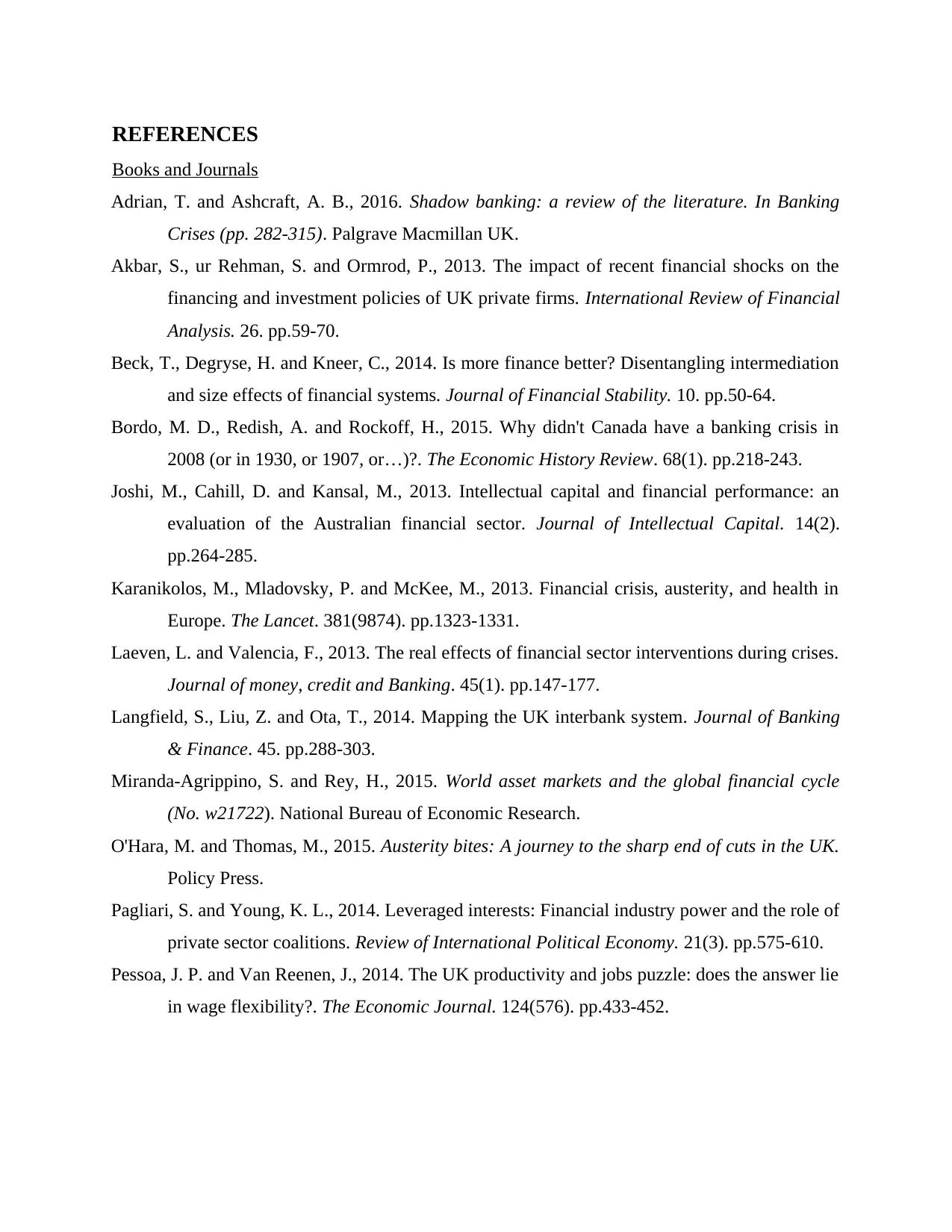
REFERENCES
Books and Journals
Adrian, T. and Ashcraft, A. B., 2016. Shadow banking: a review of the literature. In Banking
Crises (pp. 282-315). Palgrave Macmillan UK.
Akbar, S., ur Rehman, S. and Ormrod, P., 2013. The impact of recent financial shocks on the
financing and investment policies of UK private firms. International Review of Financial
Analysis. 26. pp.59-70.
Beck, T., Degryse, H. and Kneer, C., 2014. Is more finance better? Disentangling intermediation
and size effects of financial systems. Journal of Financial Stability. 10. pp.50-64.
Bordo, M. D., Redish, A. and Rockoff, H., 2015. Why didn't Canada have a banking crisis in
2008 (or in 1930, or 1907, or…)?. The Economic History Review. 68(1). pp.218-243.
Joshi, M., Cahill, D. and Kansal, M., 2013. Intellectual capital and financial performance: an
evaluation of the Australian financial sector. Journal of Intellectual Capital. 14(2).
pp.264-285.
Karanikolos, M., Mladovsky, P. and McKee, M., 2013. Financial crisis, austerity, and health in
Europe. The Lancet. 381(9874). pp.1323-1331.
Laeven, L. and Valencia, F., 2013. The real effects of financial sector interventions during crises.
Journal of money, credit and Banking. 45(1). pp.147-177.
Langfield, S., Liu, Z. and Ota, T., 2014. Mapping the UK interbank system. Journal of Banking
& Finance. 45. pp.288-303.
Miranda-Agrippino, S. and Rey, H., 2015. World asset markets and the global financial cycle
(No. w21722). National Bureau of Economic Research.
O'Hara, M. and Thomas, M., 2015. Austerity bites: A journey to the sharp end of cuts in the UK.
Policy Press.
Pagliari, S. and Young, K. L., 2014. Leveraged interests: Financial industry power and the role of
private sector coalitions. Review of International Political Economy. 21(3). pp.575-610.
Pessoa, J. P. and Van Reenen, J., 2014. The UK productivity and jobs puzzle: does the answer lie
in wage flexibility?. The Economic Journal. 124(576). pp.433-452.
Books and Journals
Adrian, T. and Ashcraft, A. B., 2016. Shadow banking: a review of the literature. In Banking
Crises (pp. 282-315). Palgrave Macmillan UK.
Akbar, S., ur Rehman, S. and Ormrod, P., 2013. The impact of recent financial shocks on the
financing and investment policies of UK private firms. International Review of Financial
Analysis. 26. pp.59-70.
Beck, T., Degryse, H. and Kneer, C., 2014. Is more finance better? Disentangling intermediation
and size effects of financial systems. Journal of Financial Stability. 10. pp.50-64.
Bordo, M. D., Redish, A. and Rockoff, H., 2015. Why didn't Canada have a banking crisis in
2008 (or in 1930, or 1907, or…)?. The Economic History Review. 68(1). pp.218-243.
Joshi, M., Cahill, D. and Kansal, M., 2013. Intellectual capital and financial performance: an
evaluation of the Australian financial sector. Journal of Intellectual Capital. 14(2).
pp.264-285.
Karanikolos, M., Mladovsky, P. and McKee, M., 2013. Financial crisis, austerity, and health in
Europe. The Lancet. 381(9874). pp.1323-1331.
Laeven, L. and Valencia, F., 2013. The real effects of financial sector interventions during crises.
Journal of money, credit and Banking. 45(1). pp.147-177.
Langfield, S., Liu, Z. and Ota, T., 2014. Mapping the UK interbank system. Journal of Banking
& Finance. 45. pp.288-303.
Miranda-Agrippino, S. and Rey, H., 2015. World asset markets and the global financial cycle
(No. w21722). National Bureau of Economic Research.
O'Hara, M. and Thomas, M., 2015. Austerity bites: A journey to the sharp end of cuts in the UK.
Policy Press.
Pagliari, S. and Young, K. L., 2014. Leveraged interests: Financial industry power and the role of
private sector coalitions. Review of International Political Economy. 21(3). pp.575-610.
Pessoa, J. P. and Van Reenen, J., 2014. The UK productivity and jobs puzzle: does the answer lie
in wage flexibility?. The Economic Journal. 124(576). pp.433-452.
Paraphrase This Document
Need a fresh take? Get an instant paraphrase of this document with our AI Paraphraser

Pratt, A. C. and Hutton, T. A., 2013. Reconceptualising the relationship between the creative
economy and the city: Learning from the financial crisis. Cities. 33. pp.86-95.
Schäfer, A., Schnabel, I. and Weder di Mauro, B., 2016. Financial sector reform after the
subprime crisis: Has anything happened?. Review of Finance. 20(1). pp.77-125.
2
economy and the city: Learning from the financial crisis. Cities. 33. pp.86-95.
Schäfer, A., Schnabel, I. and Weder di Mauro, B., 2016. Financial sector reform after the
subprime crisis: Has anything happened?. Review of Finance. 20(1). pp.77-125.
2

3
⊘ This is a preview!⊘
Do you want full access?
Subscribe today to unlock all pages.

Trusted by 1+ million students worldwide
1 out of 12
Related Documents
Your All-in-One AI-Powered Toolkit for Academic Success.
+13062052269
info@desklib.com
Available 24*7 on WhatsApp / Email
![[object Object]](/_next/static/media/star-bottom.7253800d.svg)
Unlock your academic potential
Copyright © 2020–2025 A2Z Services. All Rights Reserved. Developed and managed by ZUCOL.





